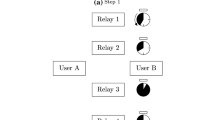Abstract
In conventional opportunistic relay selection schemes, one or multiple relays with better channel condition are selected. However, if frame aggregation is supported for improving MAC throughput, each relay can have different amounts of data and thus conventional selection schemes may choose a worse relay node only with good channel condition but little data. In this paper, we propose a novel opportunistic relay selection scheme when frame aggregation is adopted. In the proposed scheme, a relay node is selected in a distributed manner by considering the amount of data as well as channel condition, and therefore the most appropriate relay node can be chosen. Simulation results demonstrate that the proposed scheme outperforms other relay selection schemes, especially when the number of relay nodes is large.



Similar content being viewed by others
Notes
Note that most rate adaptation algorithms set the transmission rate satisfying the given target error rate and thus the error rate is almost the same regardless of the transmission rate. Therefore, we do not consider the error rate in computing \(\alpha _i\).
References
Song, T., Kim, W., & Pack, S. (Jan. 2011). Opportunistic relay selection scheme with frame aggregation, In 2011 IEEE consumer communications and networking conference (CCNC).
Lo, C.K., Heath Jr., R.W., & Vishwanath, S. (Apr. 2007). Opportunistic relay selection with limited feedback, In 2007 IEEE 65th vehicular technology conference spring.
Vicario, J., Bel, A., Lopez-Salcedo, J., & Seco, G. (2009). Opportunistic relay selection with outdated CSI: Outage probability and diversity analysis. IEEE Transactions on Wireless Communications, 8(6), 2872–2876.
Kabaoglu, N. (2013). Expectation-maximization-based joint data detection and channel estimation for a cellular multi-carrier code division multiple access network using single-hop relaying. International Journal of Communication Systems, 26(4), 449–464.
Liu, P., Tao, Z., Narayanan, S., Korakis, T., & Panwar, S. (2007). CoopMAC: A cooperative MAC for wireless LANs. IEEE Journal on Selected Areas in Communications, 25(2), 340–354.
Shea, J. M., Wong, T. F., & Wong, W.-H. (2006). Cooperative-diversity slotted ALOHA. Wireless Networks, 13(3), 361–369.
Cetin, B. (2006). Opportunistic relay protocol for IEEE 802.11 WLANs. Technical Report. Swedish Institute of Computer Science.
Biswas, S., & Morris, R. (2005). ExOR: Opportunistic multi-hop routing for wireless networks, In ACM SIGCOMM.
Liu, W., Jin, H., Wang, X., & Guizani, M. (2011). A novel IEEE 802.11-based MAC protocol supporting cooperative communications. International Journal of Communication Systems, 24(11), 1480–1495.
Kim, Y., Choi, S., Jang, K., & Hwang, H. (2004). Throughput enhancement of IEEE 802.11 WLAN via frame aggregation, In IEEE 60th vehicular technology conference, vol. 4.
Skordoulis, D., Stephens, A., & Jamalipour, A. (2008). IEEE 802.11n MAC frame aggregation mechanisms for next-generation high-throughput WLANs. IEEE Wireless Communications, 15(1), 40–47.
Lin, Y., & Wong, V.W.S. (Nov. 2006). Frame aggregation and optimal frame size adaptation for IEEE 802.11n WLANs, In IEEE globecom 2006.
Lin, Y.-D., Yeh, J.-H., Yang, T.-H., Ku, C.-Y., Tsao, S.-L., & Lai, Y.-C. (2009). Efficient dynamic frame aggregation in IEEE 802.11s mesh networks. International Journal of Communication Systems, 22(10), 1319–1338.
Bianchi, G. (2000). Performance analysis of the IEEE 802.11 distributed coordination function. IEEE Journal on Selected Areas in Communications, 18(3), 535–547.
Paul, T., & Ogunfunmi, T. (2008). Wireless LAN comes of age: Understanding the IEEE 802.11n amendment. IEEE Circuits and Systems Magazine, 8(1), 28–54.
IEEE Standard for Information technology—Local and metropolitan area networks—Specific requirements— Part 11: Wireless LAN Medium Access Control (MAC) and Physical Layer (PHY) Specifications Amendment 5: Enhancements for higher throughput, In IEEE Standard 802.11n-2009 (Amendment to IEEE Standard 802.11-2007 as amended by IEEE Standard 802.11k-2008, IEEE Standard 802.11r-2008, IEEE Standard 802.11y-2008, and IEEE Standard 802.11w-2009), pp. 1–565, (2009).
Author information
Authors and Affiliations
Corresponding author
Additional information
An extended abstract of this paper was presented at IEEE CCNC 2011 [1].
This research was supported in part by the MSIP (Ministry of Science, ICT&Future Planning), Korea, under the ITRC (Information Technology Research Center) support program supervised by the NIPA (National ICT Industry Promotion Agency) (NIPA-2014-H0301-14-1015) and in part by ICT R&D program of MSIP/IITP (2014-044-006-004, Next Generation WLAN System with High Efficient Performance).
Rights and permissions
About this article
Cite this article
Song, T., Kim, W. & Pack, S. ORS-FA: An Opportunistic Relay Selection Scheme for Frame-Aggregated Environments. Wireless Pers Commun 82, 2351–2361 (2015). https://doi.org/10.1007/s11277-015-2351-0
Published:
Issue Date:
DOI: https://doi.org/10.1007/s11277-015-2351-0




